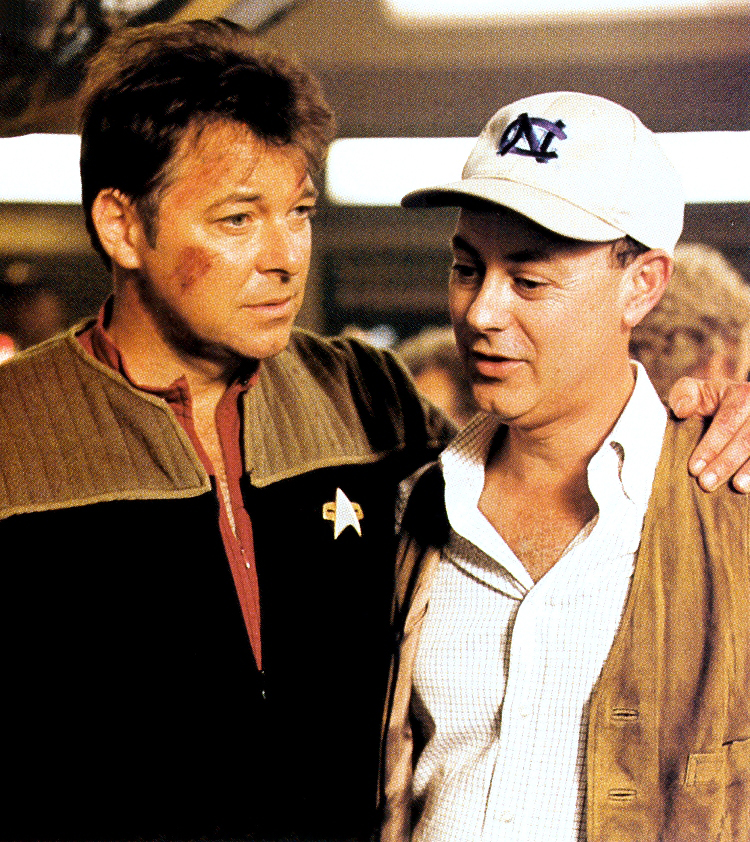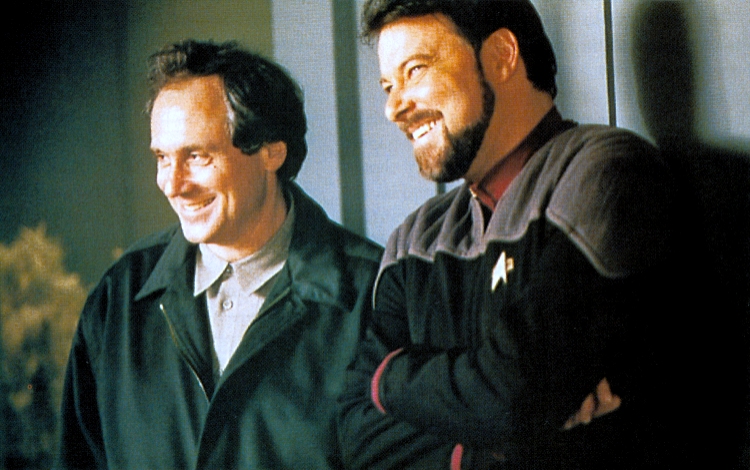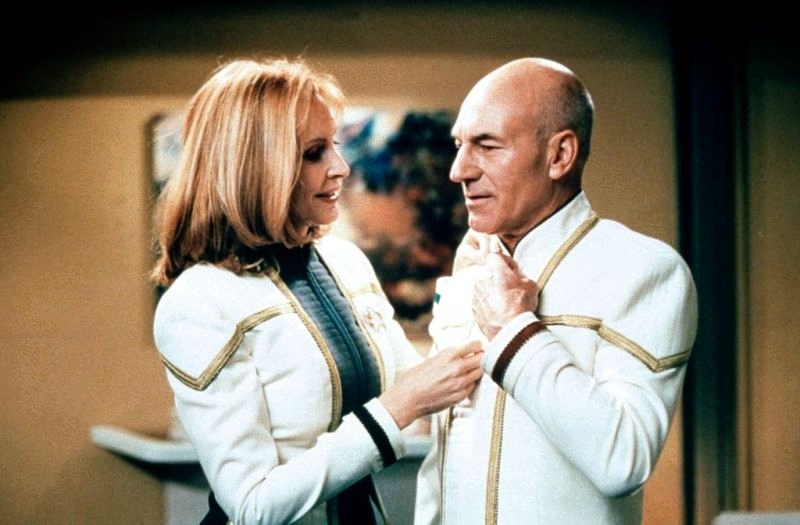Writing Star Trek: Insurrection

Michael Piller was reluctant to write a Star Trek movie. He had joined the franchise during the second year of The Next Generation, risen to become an executive producer of the series, co-created Deep Space Nine and then run Voyager for two years. By 1997, he was ready to move on.
Rick Berman, who had taken over Star Trek after Gene Roddenberry’s death in 1991, convinced him otherwise.
Four years earlier, Piller had declined the opportunity to write a script for what would become Star Trek Generations. At the studio’s insistence, Berman had commissioned two teleplays. The best one would be filmed. Piller didn’t feel like pouring his heart into a story that might never see the light of day, but he was glad the version written by Brannon Braga and Ronald D. Moore, who had both worked for him on The Next Generation, won.
This time would be different. Piller would be the only writer and, after the success of First Contact, it was virtually a certainty that a ninth Star Trek film would be made.
Piller documented the writing process in a book titled Fade In that was published online by TrekCore after his death in 2005. This story is based on that memoir.
Fountain of youth
Berman and Piller agreed from the outset that the next movie shouldn’t try to be bigger and bolder than the last.
Every big-league pitcher knows you canʼt keep throwing your fastball if you want to be successful. The last movie had been a fastball and a good one, complete with great space monsters (the Borg) and a war to save the universe. It would be a mistake, we decided, to try in this movie to “out-Borg the Borg.”
Like The Voyage Home, this would be a lighter, quirkier Star Trek film.
The central theme of youth hit Piller when ABC rejected a pilot he had written for a television series about the impact of the first televisions. The studio didn’t believe a show set the 1950s would appeal to the coveted 18-to-35-year-old demographic. (It’s a good thing Matthew Weiner didn’t pitch Mad Men to them!)
Drawing on Joseph Conrad’s Heart of Darkness, Piller imagined Picard chasing a classmate from Starfleet Academy into an inhospitable part of space to the fountain of youth. This innocent world would be threatened by villains and Picard would be forced to fight his old friend.

Berman approved of the direction and the two immediately thought of the Romulans as villains, who had yet to get the motion-picture treatment. But Piller decided it would be more dramatic to involve Starfleet as well.
This was tricky. Piller had learned on The Next Generation that Roddenberry didn’t want humans or the Federation to be evil in any way, and both he and Berman were protective of that vision. It’s why Berman wasn’t a fan of the Dominion War in Deep Space Nine.
“But we liked the idea of someone in Starfleet Command sending Picard on a mission without telling him the entire truth,” Piller wrote.
With time, Piller realized that a cabal of Romulan and Starfleet officers wouldn’t do. Picard had to go up against the entire Federation for the stakes to be high enough.
I knew Rick would have a huge problem with this. But I felt it was necessary to make the picture work and I had confidence I could do it in a way that would still honor Roddenberryʼs vision.
The story evolved into something like Robin Hood, with Picard and his crew of merry men (and women) protecting a magical world. Their working title? Stardust, after the song by Nat King Cole.
Picard and Data
This vision didn’t clash with Patrick Stewart’s own desire to have Picard not be “haunted” this time around. In Generations, the captain had been full of self-doubt following the death of his family. In First Contact, he was driven by revenge. Stewart wanted the third film to be lighter.
When it came to Data, arguably the second most important character, Piller had some clear ideas as well.
Roddenberry had created Data as his Pinnochio. The androidʼs greatest wish in life was to be human.
In the previous two movies, Data had got his wish: an emotion chip in Generations and human flesh in First Contact. Piller worried it was making the character less interesting. The next film would somehow have to bring Pinnochio back.
First attempt
Piller’s first story treatment pulled these various threads together and contained several ideas that would end up in the movie: Data skipping the officers’ weekly poker game, because he is now incapable of bluffing; Picard being ordered to chase his Academy friend, called Hugh Duffy, into a dangerous section of the Neutral Zone known as the Briar Patch; a space battle with the Romulans; a Garden of Eden-like world inhabited by telepathic mutes and hiding a medically vital ore; the Federation turning a blind eye to the Romulans occupying the planet; Picard and Data defying orders to join Duffy in defending its people.

Piller expected Berman would be critical of Picard’s defection, but that wasn’t what bothered the producer the most. It was that the story was too political. And he worried Stewart wouldn’t be happy playing a character that was “reinvigorated” by a fountain of youth only to return to an “old man” at the end of the movie.
Just when Piller was about to despair, Berman gave him the idea that would make the story work: “What if the guy Picard finds on the planet… is Data.”
Introducing a new character — Duffy — took the drama out of the Star Trek “family”. Putting Data on the planet made him the wayward son.
It would become a story about the Enterprise crew’s commitment to him, defining the crew as a family and emphasizing its importance to the franchise.
Disastrous second try
The next treatment still had Romulans. It opened with Data apparently having gone berserk during a secret mission in the Briar Patch. Picard is forced to kill him in a standoff. The crew discover the Federation’s involvement in a plot to mine the planet for its precious ore. Picard confronts an Ambassador Dougherty, who argues they’re only talking about relocating 4,000 people. Picard counters, how many before it becomes wrong? He resigns from Starfleet to help the natives resist a Romulan takeover. Data is brought back to life. The Enterprise leads a ragtag fleet of civilian Federation vessels to beat the Romulans.
Berman and most of the studio executives approved. The only one who raised red flags was Jonathan Dolgen, chairman of Viacom Entertainment Group — and the only Trekker in the group. He didn’t care for the Romulan villain Piller had invented. He hated the telepathic mutes. He thought there weren’t enough space action scenes. And he felt that the Federation’s arguments actually made sense. The audience might think Picard was on the wrong side of the issue.

Then the final blow — Patrick Stewart hated the story even more.
More than any other single factor, Piller felt Stewart had been responsible for the success of The Next Generation.
His controlled performance brought an instant credibility to every outrageous space scenario. There was never a dishonest moment on screen. As a viewer, you simply believed everything he said and did.
So if Stewart wasn’t happy, this story wasn’t going anywhere.
“It has no sweep,” Stewart wrote to Pillar. “It has no surprises. It has no scale. It has little humor. It has no romance. It breaks no new ground. It under-uses our cast. It has little fun. It is dull.”
In the best Star Trek nitpicking tradition, Stewart also identified many shortcomings and plot holes in the story outline.
Berman and Piller initially pushed back, but after mailing several letters back and forth they realized Stewart made good points. Berman went back to where they had started: the foundation of youth. To his surprise, Stewart wasn’t threatened by the idea of making Picard seem old at all.
“In all my anger,” wrote Piller, “I had to acknowledge to myself that Patrick had moved us back to the story I wanted to tell in the first place.”
Third time’s a charm — mostly
Despite Dolgen’s and Stewart’s doubts, Berman and Piller were confident the premise of Picard resigning his commission to defend a small group of helpless aliens would be powerful on the silver screen. They also knew that Data versus Picard was gold, so the renegade android stayed in.
The Romulans went out. Piller had to come up with a new villain. The telepathic mutes went out as well and the planet’s inhabitants became an ageless human-like race. Data would now rebel after discovering a plan to transport the whole population onto a holoship and, after learning the truth, Picard would join him.

Stewart approved and Piller wrote his third story treatment. The new villains were the Son’i (later changed to Son’a, because Son’i sounded too much like Sony), an extremely old people led by one Ru’afo. The ageless natives are called the Ba’ku. A lot of the second act was spent showing the de-aging effects on the Enterprise crew, with Picard developing affections for an old friend from his Academy days, who led the Starfleet surveying mission to Ba’ku: Eleanor. It turns out she knew about the Federation-Son’i plot to relocate the Ba’ku and mine their world for resources. Picard convinces her to join an insurrection on the planet before beaming aboard Ru’afo’s ship with the intention of capturing him, only to discover that the Son’i and the Ba’ku are the same race. The movie ends with Picard negotiating a truce.
When Piller had finally written his script, it was Ira Steven Behr, who had taken over day-to-day management of Deep Space Nine, who raised the critical questions: Coming after the Borg, the Son’i seemed like paper tigers to him. There was no real “hero’s journey” for Picard. And were they really getting all they wanted out of the fountain of youth?
Piller struggled to make the script better. He came up with a couple of ideas:
- The de-aging effect would be caused by an element not on the planet but surrounding it, allowing for more storytelling in space.
- In order to make Picard’s defection more credible, he would bond with a Ba’ku woman. Eleanor was gone.
He also found answers to Behr’s questions. The real villain of the movie wouldn’t be the Son’i, but Dougherty: a decent man who thought he represented a noble cause, but slowly compromises his ideals to get the job done. Picard’s “hero’s journey” would be subtle: from being bogged down in bureaucracy to rediscovering the joy of adventure. The fountain of youth would provide funny and warm moments, from Worf experiencing puberty to Riker and Troi rekindling their romance.
Berman and Piller negotiated their way through the script page by page, line by line, until they were both satisfied. Studio executives had more notes that led to improvements.
Final tweaks
By this time, Jonathan Frakes had been hired to direct and Piller was officially co-producing. The script was circulated around Paramount to get cost estimates from the various departments, which led to a leak. A poorly-written synopsis worried fans, who wrote angry letters. Entertainment Weekly reported that Trekkers were unenthusiastic about the upcoming “kinder, gentler Trek.”
Piller tried to ignore it all.
There were still tweaks to be made. Instead of defending the Ba’ku village Alamo-style, the Enterprise crew would lead the people into the mountains. But Piller wanted to avoid too many cave scenes, so he wrote an outdoors battle. The final confrontation between Picard and Ra’ufo felt too similar to Picard’s battle with Soran in Generations. Piller made changes. Patrick Stewart suggested having Data and Picard sing Gilbert and Sullivan. Anij was originally supposed to die, but Piller changed his mind. “Picard would be more heroic if he could save her life.”
A read-through with the entire cast yielded a few more changes in lines that sounded awkward.
The only thing left to do now was find a title. Stardust didn’t work anymore. Regeneration was rejected. Berman and Piller considered Prime Directive, The Betrayal, Breach of Promise, Dereliction of Duty, The Dishonor, High Treason, The Enemy Within, The Resignation and Apostasy. Later suggestions included Beyond Paradise, Forever and Where Time Stands Still, but marketing argued it was important to have an action title. Piller’s favorite, Sacred Honor (using the last two words of the American Declaration of Independence) was rejected, because it might sound too religious.
Marketing proposed Revolution, but Berman objected — the movie wasn’t about a revolution. Dolgen agreed. Insurrection was ultimately suggested by two outsiders, including Alan Spencer, a writer friend of Piller’s.
Finally they were ready to shoot.
